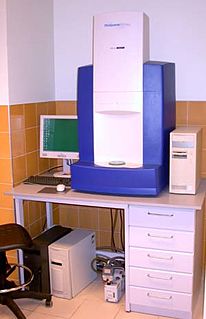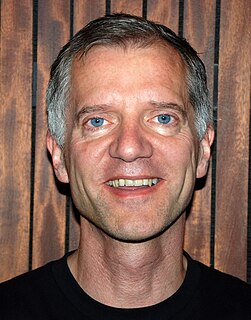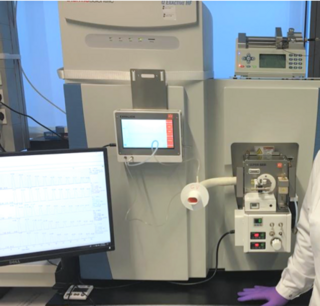Related Research Articles
Mass spectrometry (MS) is an analytical technique that is used to measure the mass-to-charge ratio of ions. The results are presented as a mass spectrum, a plot of intensity as a function of the mass-to-charge ratio. Mass spectrometry is used in many different fields and is applied to pure samples as well as complex mixtures.

Electrospray ionization (ESI) is a technique used in mass spectrometry to produce ions using an electrospray in which a high voltage is applied to a liquid to create an aerosol. It is especially useful in producing ions from macromolecules because it overcomes the propensity of these molecules to fragment when ionized. ESI is different from other ionization processes since it may produce multiple-charged ions, effectively extending the mass range of the analyser to accommodate the kDa-MDa orders of magnitude observed in proteins and their associated polypeptide fragments.

Tandem mass spectrometry, also known as MS/MS or MS2, is a technique in instrumental analysis where two or more mass analyzers are coupled together using an additional reaction step to increase their abilities to analyse chemical samples. A common use of tandem MS is the analysis of biomolecules, such as proteins and peptides.

In mass spectrometry, matrix-assisted laser desorption/ionization (MALDI) is an ionization technique that uses a laser energy absorbing matrix to create ions from large molecules with minimal fragmentation. It has been applied to the analysis of biomolecules and various organic molecules, which tend to be fragile and fragment when ionized by more conventional ionization methods. It is similar in character to electrospray ionization (ESI) in that both techniques are relatively soft ways of obtaining ions of large molecules in the gas phase, though MALDI typically produces far fewer multi-charged ions.

Liquid chromatography–mass spectrometry (LC–MS) is an analytical chemistry technique that combines the physical separation capabilities of liquid chromatography with the mass analysis capabilities of mass spectrometry (MS). Coupled chromatography - MS systems are popular in chemical analysis because the individual capabilities of each technique are enhanced synergistically. While liquid chromatography separates mixtures with multiple components, mass spectrometry provides spectral information that may help to identify each separated component. MS is not only sensitive, but provides selective detection, relieving the need for complete chromatographic separation. LC-MS is also appropriate for Metabolomics because of its good coverage of a wide range of chemicals. This tandem technique can be used to analyze biochemical, organic, and inorganic compounds commonly found in complex samples of environmental and biological origin. Therefore, LC-MS may be applied in a wide range of sectors including biotechnology, environment monitoring, food processing, and pharmaceutical, agrochemical, and cosmetic industries.

Ion mobility spectrometry (IMS) is an analytical technique used to separate and identify ionized molecules in the gas phase based on their mobility in a carrier buffer gas. Though heavily employed for military or security purposes, such as detecting drugs and explosives, the technique also has many laboratory analytical applications, including the analysis of both small and large biomolecules. IMS instruments are extremely sensitive stand-alone devices, but are often coupled with mass spectrometry, gas chromatography or high-performance liquid chromatography in order to achieve a multi-dimensional separation. They come in various sizes, ranging from a few millimeters to several meters depending on the specific application, and are capable of operating under a broad range of conditions. IMS instruments such as microscale high-field asymmetric-waveform ion mobility spectrometry can be palm-portable for use in a range of applications including volatile organic compound (VOC) monitoring, biological sample analysis, medical diagnosis and food quality monitoring. Systems operated at higher pressure are often accompanied by elevated temperature, while lower pressure systems (1-20 hPa) do not require heating.

The history of mass spectrometry has its roots in physical and chemical studies regarding the nature of matter. The study of gas discharges in the mid 19th century led to the discovery of anode and cathode rays, which turned out to be positive ions and electrons. Improved capabilities in the separation of these positive ions enabled the discovery of stable isotopes of the elements. The first such discovery was with the element neon, which was shown by mass spectrometry to have at least two stable isotopes: 20Ne and 22Ne. Mass spectrometers were used in the Manhattan Project for the separation of isotopes of uranium necessary to create the atomic bomb.

Matthias Mann is a scientist in the area of mass spectrometry and proteomics.
Donald F. Hunt is the University Professor of Chemistry and Pathology at the University of Virginia. He is known for his research in the field of mass spectrometry, he developed electron capture negative ion mass spectrometry. He has received multiple awards for his work including the Distinguished Contribution Award from the American Society for Mass Spectrometry and the Thomson Medal from the International Mass Spectrometry Society.

Desorption electrospray ionization (DESI) is an ambient ionization technique that can be coupled to mass spectrometry (MS) for chemical analysis of samples at atmospheric conditions. Coupled ionization sources-MS systems are popular in chemical analysis because the individual capabilities of various sources combined with different MS systems allow for chemical determinations of samples. DESI employs a fast-moving charged solvent stream, at an angle relative to the sample surface, to extract analytes from the surfaces and propel the secondary ions toward the mass analyzer. This tandem technique can be used to analyze forensics analyses, pharmaceuticals, plant tissues, fruits, intact biological tissues, enzyme-substrate complexes, metabolites and polymers. Therefore, DESI-MS may be applied in a wide variety of sectors including food and drug administration, pharmaceuticals, environmental monitoring, and biotechnology.

David E. Clemmer is an analytical chemist and the Distinguished Professor and Robert and Marjorie Mann Chair of Chemistry at Indiana University in Bloomington, Indiana, where he leads the Clemmer Group. Clemmer develops new scientific instruments for ion mobility mass spectrometry (IMS/MS), including the first instrument for nested ion-mobility time-of-flight mass spectrometry. He has received a number of awards, including the Biemann Medal in 2006 "for his pioneering contributions to the integration of ion mobility separations with a variety of mass spectrometry technologies."
Scott A. McLuckey is an American chemist, the John A. Leighty Distinguished Professor of Chemistry at Purdue University. His research concerns the formation of ionized versions of large biomolecules, mass spectrometry of these ions, and ion-ion reactions.

Laser spray ionization refers to one of several methods for creating ions using a laser interacting with a spray of neutral particles or ablating material to create a plume of charged particles. The ions thus formed can be separated by m/z with mass spectrometry. Laser spray is one of several ion sources that can be coupled with liquid chromatography-mass spectrometry for the detection of larger molecules.
Michael L. Gross is Professor of Chemistry, Medicine, and Immunology, at Washington University in St. Louis. He was formerly Professor of Chemistry at the University of Nebraska-Lincoln from 1968–1994. He is recognized for his contributions to the field of mass spectrometry and ion chemistry. He is credited with the discovery of distonic ions, chemical species containing a radical and an ionic site on different atoms of the same molecule.

Ion mobility spectrometry–mass spectrometry (IMS-MS) is an analytical chemistry method that separates gas phase ions based on their interaction with a collision gas and their masses. In the first step, the ions are separated according to their mobility through a buffer gas on a millisecond timescale using an ion mobility spectrometer. The separated ions are then introduced into a mass analyzer in a second step where their mass-to-charge ratios can be determined on a microsecond timescale. The effective separation of analytes achieved with this method makes it widely applicable in the analysis of complex samples such as in proteomics and metabolomics.
Richard Dale Smith is a chemist and a Battelle Fellow and Chief Scientist within the Biological Sciences Division, as well as the Director of Proteomics Research at the Pacific Northwest National Laboratory (PNNL). Dr. Smith is also Director of the NIH Proteomics Research Resource for Integrative Biology, an adjunct faculty member in the chemistry departments at Washington State University and the University of Utah, and an affiliate faculty member at the University of Idaho and the Department of Molecular Microbiology & Immunology, Oregon Health & Science University. He is the author or co-author of approximately 1100 peer-reviewed publications and has been awarded 70 US patents.

Catherine Clarke Fenselau is an American scientist who was the first trained mass spectrometrist on the faculty of an American medical school; she joined Johns Hopkins School of Medicine in 1968. She specializes in biomedical applications of mass spectrometry. She has been recognized as an outstanding scientist in the field of bioanalytical chemistry because of her work using mass spectrometry to study biomolecules.
Renã A. S. Robinson is an associate professor and the Dorothy J. Wingfield Phillips Chancellor's Faculty Fellow in the Department of Chemistry at the Vanderbilt University, where she is the principal investigator of the RASR Laboratory.

Secondary electro-spray ionization (SESI) is an ambient ionization technique for the analysis of trace concentrations of vapors, where a nano-electrospray produces charging agents that collide with the analyte molecules directly in gas-phase. In the subsequent reaction, the charge is transferred and vapors get ionized, most molecules get protonated and deprotonated. SESI works in combination with mass spectrometry or ion-mobility spectrometry.
Ying Ge is a Chinese-American biologist who is a Professor of Cell and Regenerative Biology at the University of Wisconsin–Madison. Her research considers the molecular mechanisms that underpin cardiac disease. She has previously served on the Board of Directors of the American Society for Mass Spectrometry. In 2020 Ge was named on the Analytical Scientist Power List.
References
- ↑ “Indiana University Bloomington.” Department of Chemistry, Indiana University, www.chem.indiana.edu/faculty/martin-f-jarrold/.
- ↑ Jarrold, Martin F. “About Professor Martin F. Jarrold.” MFJ Research Group, Indiana University Chemistry Department, www.indiana.edu/~nano/about/.
- ↑ Clemmer, David E, Jarrold, Martin F. (1997). "Ion Mobility Measurements and their Applications to Clusters and Biomolecules". Journal of Mass Spectrometry. 32 (6): 577–592. doi:10.1002/(SICI)1096-9888(199706)32:6<577::AID-JMS530>3.0.CO;2-4.
- ↑ Pierson, Elizabeth E. (2014). "Detection of Late Intermediates in Virus Capsid Assembly by Charge Detection Mass Spectrometry". Journal of the American Chemical Society. 136 (9): 3536–41. doi:10.1021/ja411460w. PMC 3985884 . PMID 24548133.
- ↑ Jarrold, Martin F. “Publications.” MFJ Research Group, Indiana University Chemistry Department, www.indiana.edu/~nano/publications/.
- ↑ "John B. Fenn Distringuished Contribution". American Society for Mass Spectrometry. Retrieved 4 November 2018.